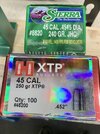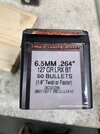So I am working on developing a new load for my M1917 because I got a good deal on 500 of 180gr SMK factory seconds. These perform much differently than the Hornady 178 match bullets I currently use. My question is what are the factors behind the vast differences between these 2 bullets. I noticed the max charge on AA4350 was 55.9gr for the Hornady 178gr match bullet and 60.3gr max for the 180gr SIE SBT. Since the weight is almost exactly the same, then is it the angle of the ogive that dictates how much pressure the bullet can handle? Thanks.
research the two bullets for jacket hardness/thickness
then, wet mark up a surface and roll each onto it, to get the length of bearing surface
if the two match up, they will act the same regarding internal ballistics, in ONE particular gun
the big difference is simply different companies and their position
there simply is NO specific reason other than that is what they post
I have often found, when researching, the SAME bullet/cartridge/powder combo with wildly varying charges from different companies
I believe this is due to MANY factors, not the least of which is the Lawyers on retainer, but also, EVERY gun is different
as is every cartridge capacity etc....
What I have often done, when starting with a different gun/bullet/powder...
I gather as many loads I can, Min/Max from EVERYWHERE
then compare them... and disregard the lowest/highest published
Then I take the average mean and make a note of that
then I go 10% (if powder appropriate) BELOW that, and check velocity, compare to published. This proofs the mean.
Then I take the mean/New max and go up 90% and that is MY max
Then I ladder loads and go from mean to MY max, checking for accuracy nodes, and work from them
I have found there is NEVER a good reason to load to max if you can find an accurate load between mean/max
Targets and Game NEVER know the difference



